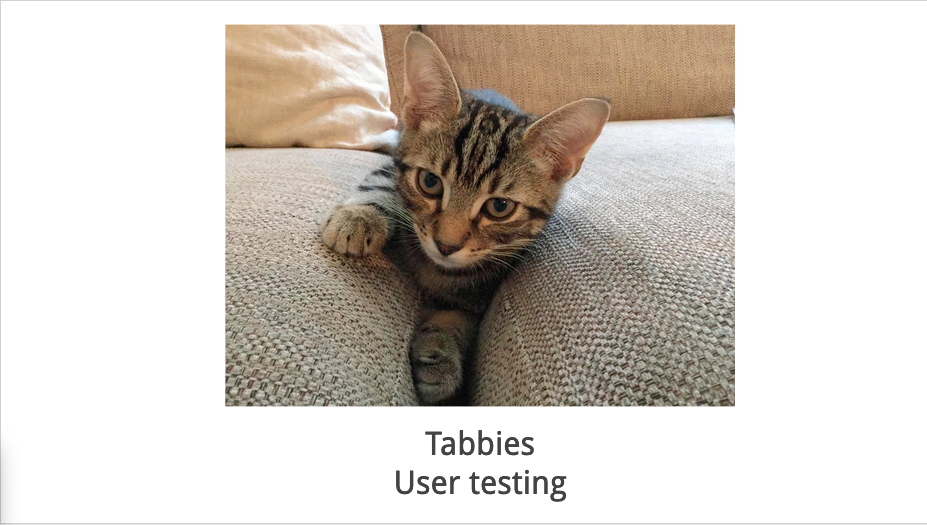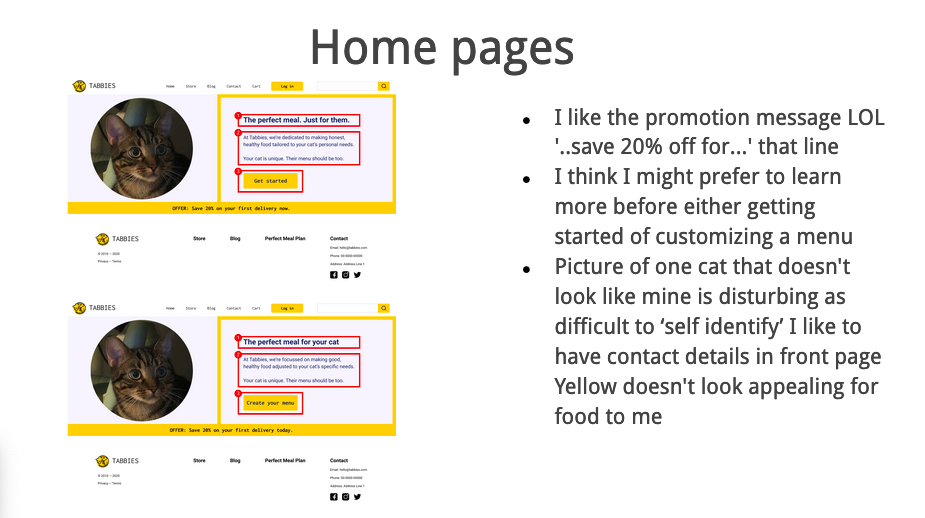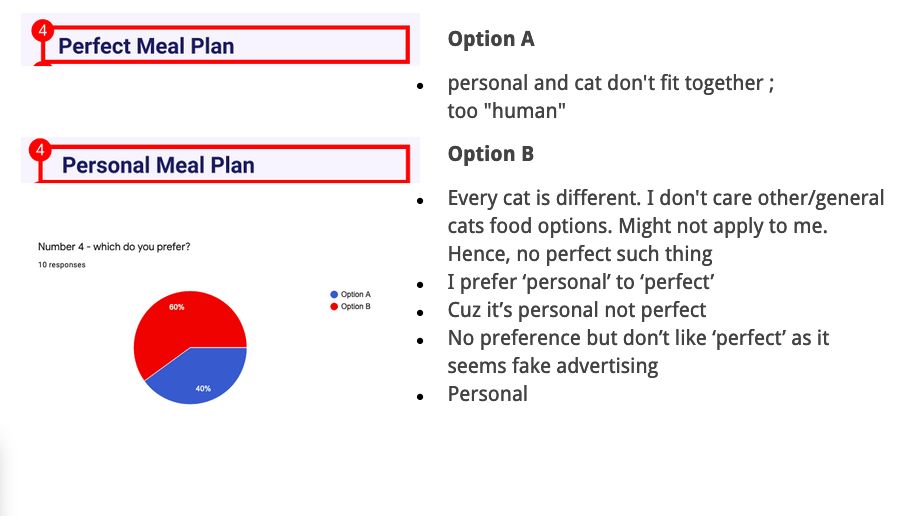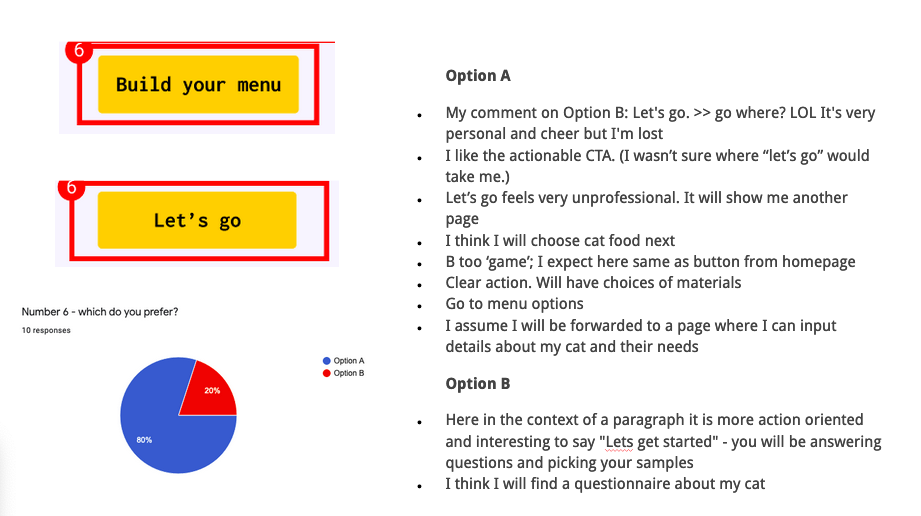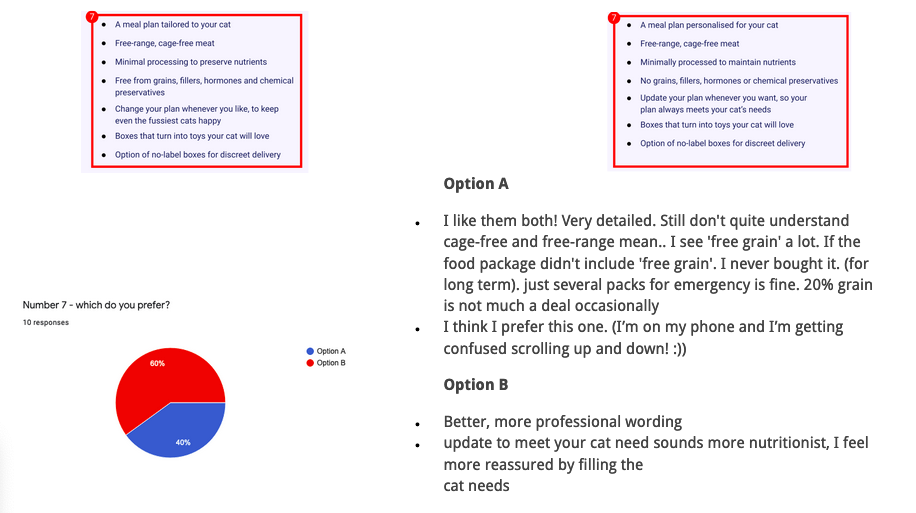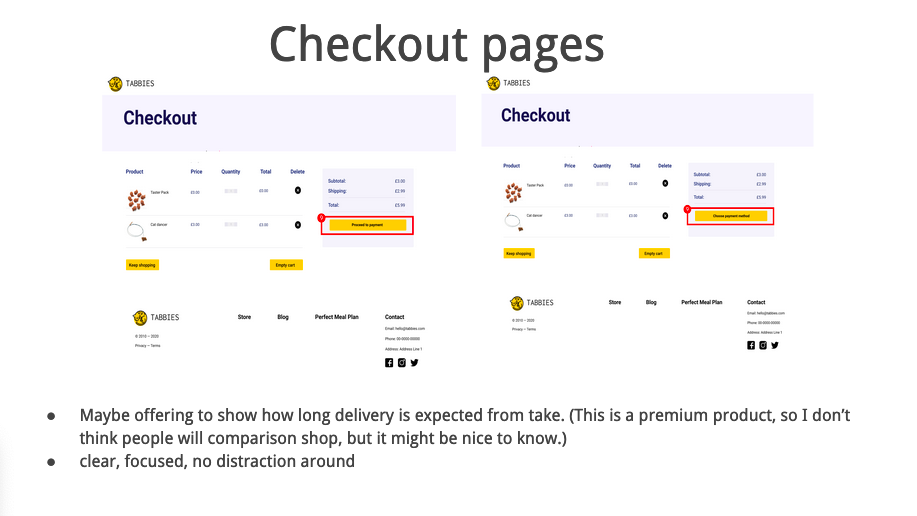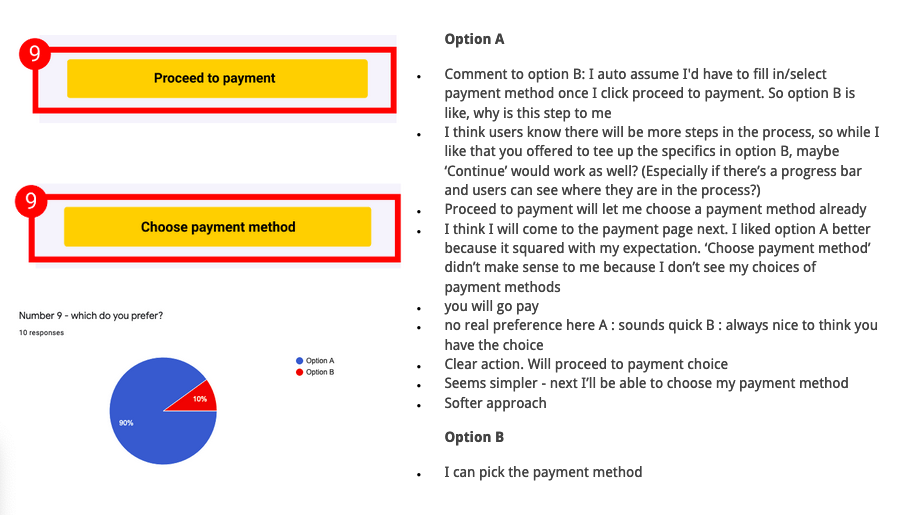Tabbies
Tabbies is a fictional startup company that wants to deliver nutritious, tailored cat food to cat owners. They want to provide peace-of-mind by helping to produce a menu tailored for each cat’s particular needs, to keep them happy and healthy.
Case study: UX writing research
Scenario
In order to get their tailored menu subscription service off the ground, Tabbies needs to conduct some user research.
The first step in this process is to put together a research plan.
Research plan
Research goals
Understand the current market of cat food via subscription
Get to know who our potential users are and where to find them
Identify our users’ needs, goals and pain points
Determine how to create engaging conversations with our users
Research methods
Competitor analysis - This will enable me to identify competing companies and determine how they approach the subscription business model and, if applicable, the customised menu service. I will note product range, prices, features, subscription levels, and how they interact with their users
Conversation mining - Learn more about our potential users.
User to business - Collect reviews of similar products on their providers’ websites and social media pages, and on Amazon and similar online platforms. This should provide information on who our potential users are, and what their needs and pain points are.
User to user Explore relevant social media groups for cat owners on Facebook, Reddit, etc. This should help to determine where our potential users can be found, and by mining vocabulary and phrases, how to make the copy I write engaging with them.
User survey This will help to identify user goals and pain points, and where gaps exist in the current market.
[Possible] Expert interviews This will help to understand the current market for healthy cat food, and especially how best to work with cat owners to provide a customised menu for their cat’s particular needs.
User personas - By creating a few ‘ideal users’, I can work to ensure that whatever copy I create is engaged with their needs.
Potential participants
Cat owners looking to give their cat a more healthy diet
Cat owners dealing with specific health issues for their cat
Owners of aging cats
People interested in adopting a cat
Pet supply store owners
Vets
Timeline
Days 1-2: Plan research and competitor analysis
Days 3-6: Conversation mining, survey preparation
Days 6-9: Collect survey data
Days 9-10: Write user personas, organise findings
Days 10-12: Present findings
Competitor analysis
I started by compiling a database of companies offering a similar service.
I collected information on their product categories and costs. I also studied their design patterns to understand the methods they used to interact with their customers.
This data was organised in an Airtable database.
Companies
Products
Design patterns
Conversation mining
Now that I have an understanding of which other companies provide a similar service to Tabbies, it’s time to really get to know the users.
To do this, I carried out a process called conversation mining:
User to business - I collected reviews of similar products on their providers’ websites and social media pages, and on online review platforms. This should provide information on who our potential users are, and what their needs and pain points are.
User to user I explored social media groups for cat owners on Facebook and Reddit, as well as online forums for cat owners. This should help to determine where our potential users can be found, and by mining vocabulary and phrases, how to make the copy we write engaging with them.
This helped me to determine who the users are, where they can be found, and what their goals, fears and pain points are.
Doing both user-to-business and user-to-user conversation mining is important because the way that users communicate with businesses is often different to how they communicate with eachother.
I also highlighted copy that caught my eye. When figuring out how to write copy that engages with a particular user group, I study how they communicate, and see what words and phrases they use.
This data was organised in an Airtable database.
User to business
User to business
User to user
User surveys
Now that I have an understanding of what our potential users’ goals, fears and pain points are, it would be very helpful to add some depth to this knowledge.
I like to conduct user surveys to gain more knowledge about users, and also determine not just what they care about, but how much they care.
I put together a survey targeting cat owners and shared it with relevant social media groups and online forums. I tried to use the funnel approach, starting with simpler, more general questions, then increasing the complexity before returning to some more general questions to finish.
The survey was made using Google Docs.







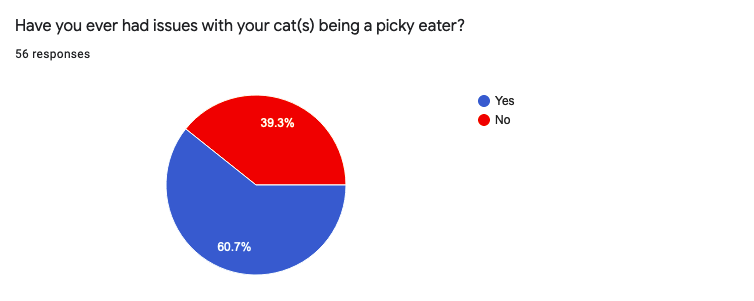
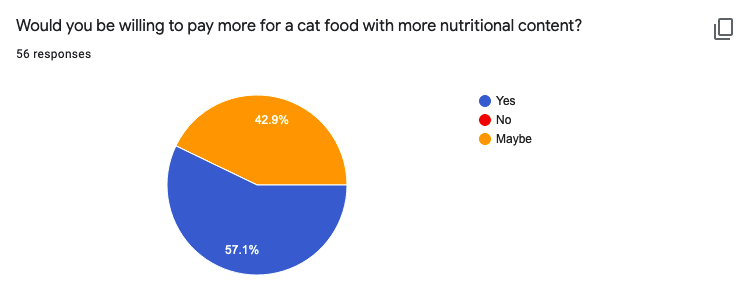

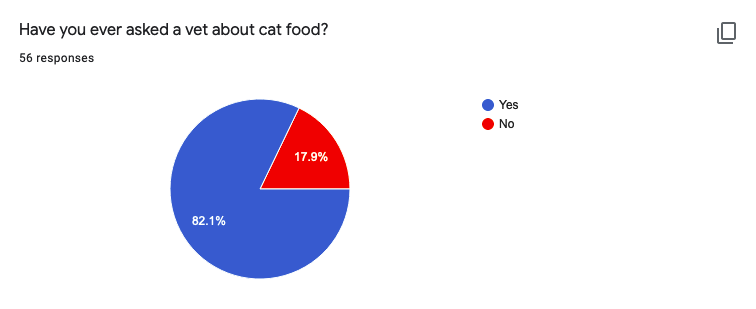
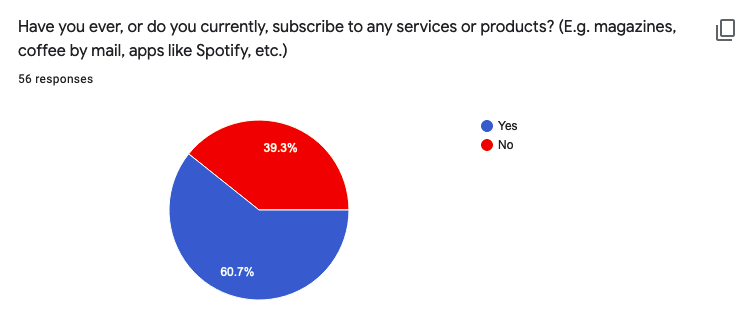


User personas
Now that I’ve identified our potential users through competitor analysis, conversation mining and a user survey, it’s useful to create a few user personas.
User personas are imagined users of a product who can help guide design and copywriting choices. They embody the needs, expectations, and characteristics of the larger user base.
-

Amy, 31
Amy has one cat.
She tends to buy her cat food online.
Her cat is a picky eater who only eats dry food.
She’s switched cat food brands before, trying to find a balance between the best nutritional value and food that her cat would eat. She also added a special food due to her cat experiencing urinary issues.
Nutritional content is the main thing she pays attention to when selecting a cat food. She is prepared to pay more for a cat food with more nutritional content.
She trusts cat food companies somewhat. She’s asked her vets about the best food for her cat.
She uses subscription services for language learning, travel and pet supplies. She finds them useful because of the opportunity for cost saving, and to help her stay organised.
Goals
Giving her cat a healthy and happy life.
Pains
Cat with picky eating habits.
Cost of specialist cat food.
Smelly litter box.
Fears
Her cat suffering health problems.
-

Charlie, 24
Charlie has one cat.
He buys his cat food online.
He feeds his cat a mix of wet and dry food.
He hasn’t switched cat food brands before. Finding a food his cat is happy to eat is his main priority. His cat hasn’t proved to be a picky eater so far.
He might be willing to pay more for a cat food with more nutritional content.
He trusts cat food companies somewhat. He hasn’t asked his vet about cat food before.
He uses subscription services for music, television and sports. He finds them convenient.
Goals
He uses subscription services for music, television and sports. He finds them convenient.
Pains
Smelly litter box.
Fears
His cat suffering health problems.
-

Tina, 41
Tina buys her cat food at the store.
She feeds her cat a mix of wet and dry food.
She’s switched cat food brands before, trying to find a low calorie food that would actually help her cats lose/keep a healthy weight. She has one obese cat, and one with skin/respiratory allergies. She’s switched their foods a lot. Calories are the one thing she can usually find pretty easily, but she finds it's not highlighted well.
Her cats can sometimes be picky, especially one of them, who likes variety.
She pays attention to the impact of cat food on heath issues with her cats. She is open to paying more for cat food with more nutritional content.
She doesn’t particularly trust cat food companies. She’s spoken to vets before about cat food.
She doesn’t tend to use subscription services, as she’s sceptical about terms, conditions and prices.
Goals
Improve her cats’ health.
Pains
Suspicious over content of food.
Cats with picky eating habits.
Difficulty finding right food.
Fears
Her cats suffering health problems.
Predatory pricing systems.
-

Ellie, 38
Ellie is a vet.
She regularly treats health issues in cats, and looks after the everyday health.
Her patients regularly ask her about what food is best for their cat.
She keeps up to date on the lastest developments in the cat food market.
She helps to decide which kinds of cat food are sold in her veterinary practice.
Goals
Help cat owners look after their cats’ health.
Pains
Suspicious over content of food.
Fears
Cats suffering health issues or obesity.
Research report
Now that I’ve conducted competitor analysis, conversation mining and a user survey, and created user personas, it’s time to present my research findings.
This is a way to brief the client on what we’ve discovered, and also make recommendations for marketing and content strategy.
The report was made using Google Slides. The full report contains slides on the competitor analysis, conversation mining, user research and user personas, but as this content is shown above I’ve not duplicated it here.
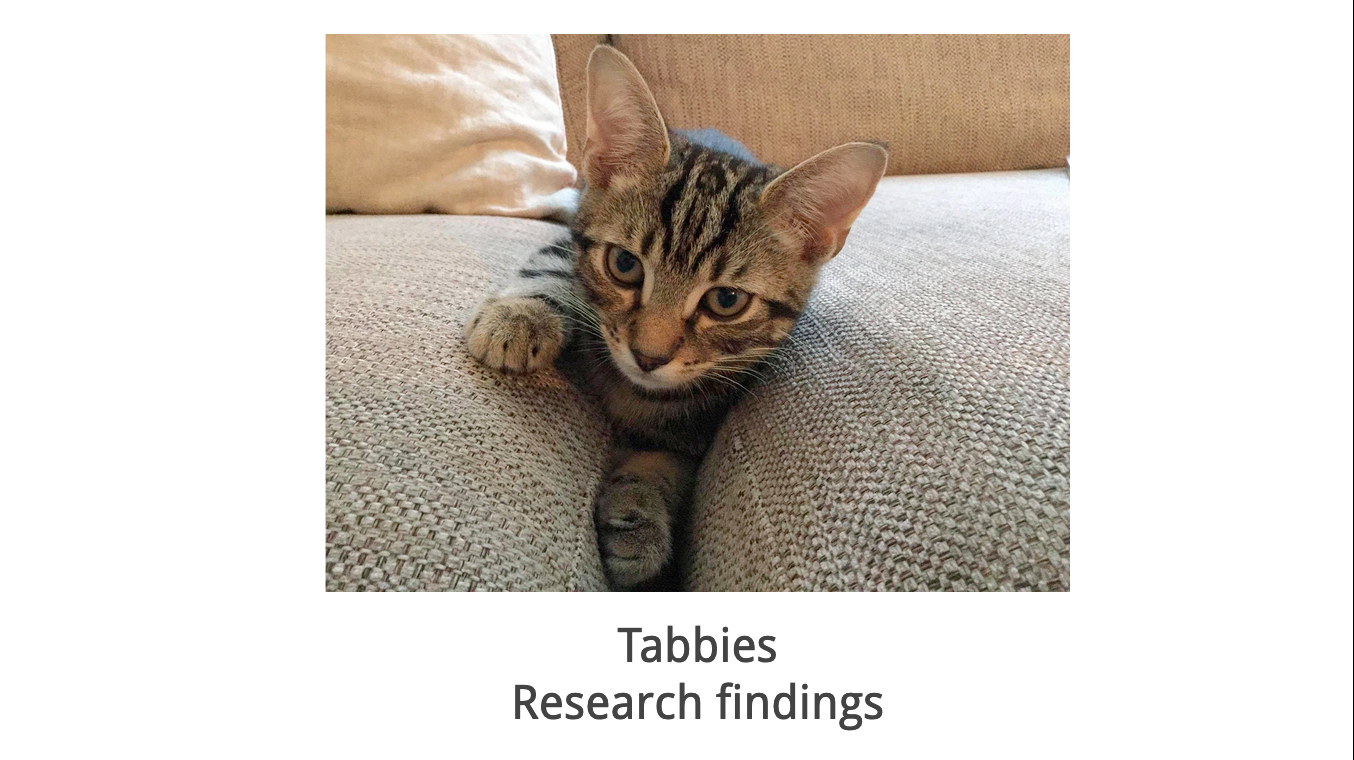

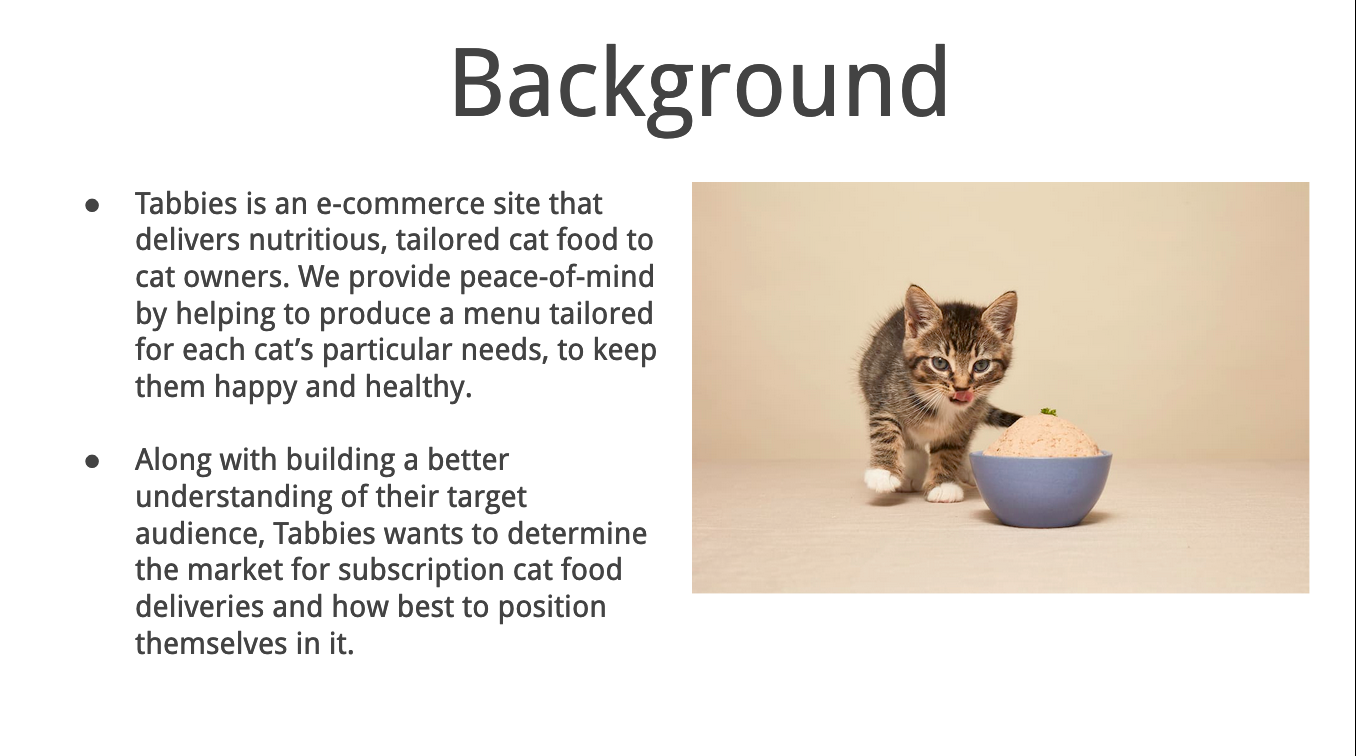




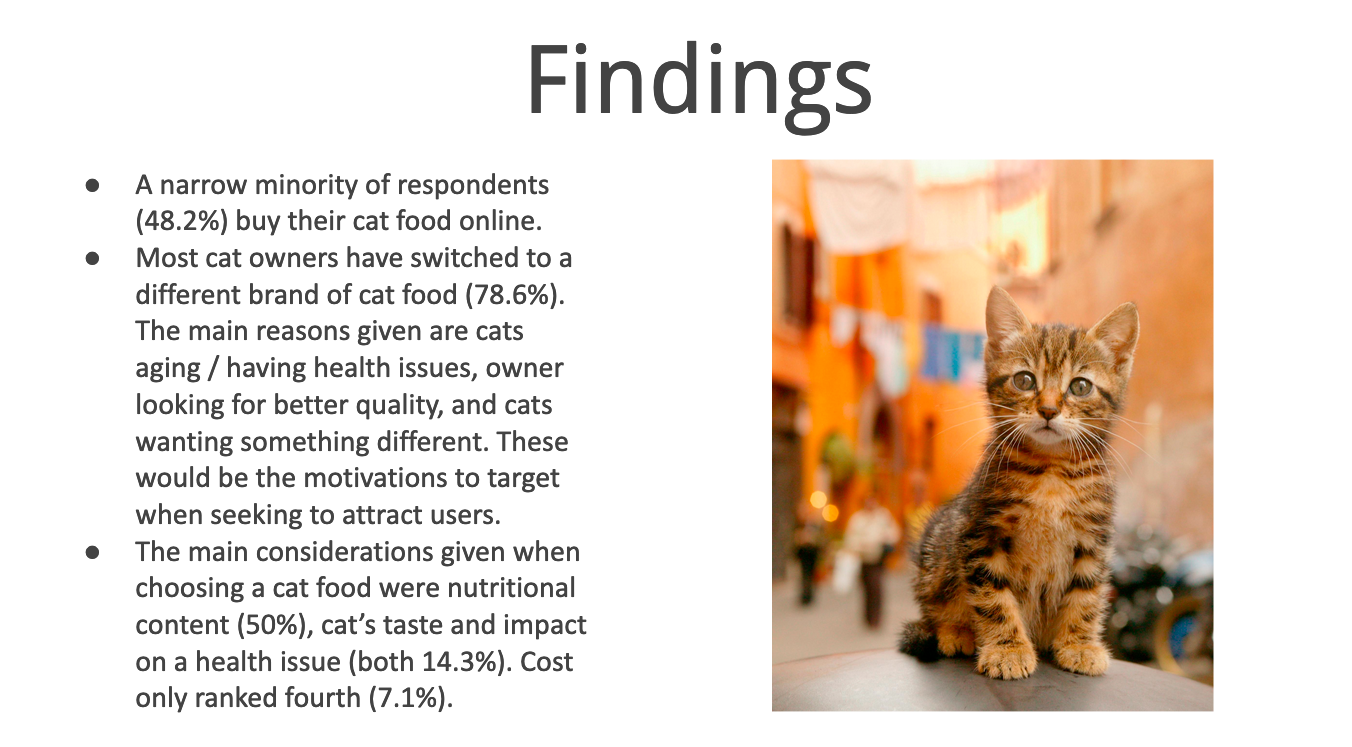

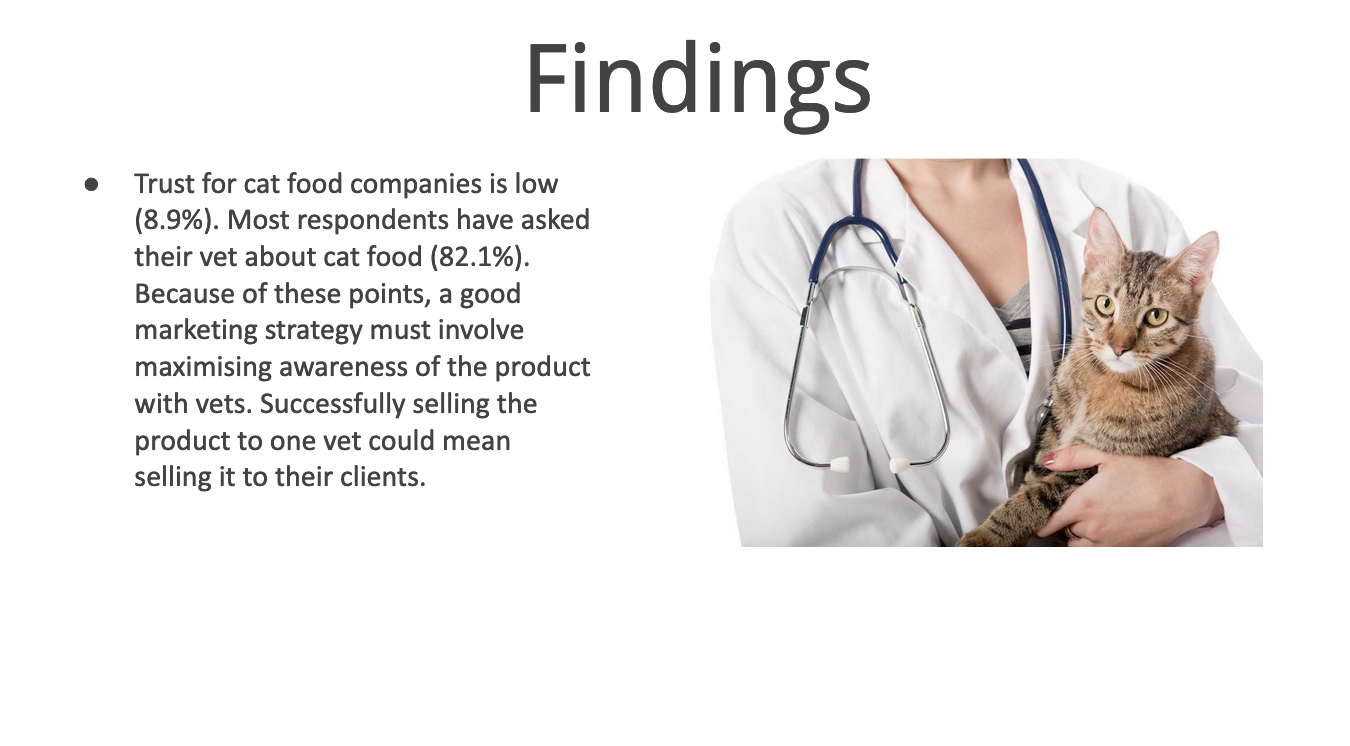

Case study: Content style guide
Scenario
Now that I have a clearer understanding of our users, its useful to create a content style guide to help inform the copy and content for Tabbies, make the product’s voice consistent and shape its personality. Anyone who works on content for Tabbies should refer to it.
I started by establishing a mission statement for Tabbies and their content.
Content mission statement
Tabbies is where conscientious cat owners can go to get nutritious cat food that is tailored to their furry friend’s particular needs, to keep them healthy and happy.
Next, it’s useful to define Tabbies in three characteristics, and establish some do’s and don’ts, so anyone working on content for Tabbies in the future has some grounding.
Characteristic 1: Caring
Tabbies’s potential users care deeply about their cats’ wellbeing, and Tabbies needs to always match that if they want users to stick with them.
Conversation mining examples:
‘But most importantly, he feels good. We're so grateful for the people at Darwin's and their commitment to providing quality, healthy food for our furry ones.’
‘Customer service is exceptional, they are very attentive and responsive to concerns, the company has a small, caring family feel when you interact with them.’
‘Because Vet Pet Box is veterinarian owned and operated, you can tell they really care about your furry babies health.’
Do:
Show compassion by addressing the user directly, say 'you'
Talk about the user's cat (the product is for them after all)
Always try to understand clearly the user's particular situation and look for tailored solutions
Don’t
Feign interest or concern
Look for one-size-fits-all solutions
Over-apologise
Characteristic 2: Knowledgable
Tabbies wants users to put their trust in them, and that means projecting a sense that they know what they’re talking about. Tabbies users are generally well-informed about cat food nutritional content, and they expect their provider to be too.
Conversation mining examples:
‘I did a LOT of research and knew exactly what I wanted in terms of nutritional content for my diabetic cat - <5% calories from carbs, the rest split between protein and fat with slightly more protein than fat. This is a lot harder to find that you would think!’
‘I've been researching for months looking for the best switch for my two "quarantine cats".‘
‘I like that it doesn't use bone. High bone content is one way I think some raw food manufacturers keep their costs down.’
‘I plan on researching as much as I can about cat nutrition and the raw diet before I even attempt to try a new diet.’
Do:
Impress the user with smart, helpful copy
Make the user feel safe and reassured
Provide details about what is and isn't in the food, as a lot of users will be seeking out this info
Don’t
Overload the copy with specialist jargon
Be condescending
Lecture or guilt-trip users
Characteristic 3: Transparent
Tabbies aims to provide reassurance and encourage trust by being clear about everything from what goes into their food and how the user’s subscription works.
Conversation mining examples:
‘Darwin's made the information I needed to make decisions about raw cat food easy to access and understand.’
‘What they fail to make clear is that when you buy this "trial pack", they are really setting you up on a wildly overpriced recurring auto shipment.’
‘Cat Person made it easy to understand what is actually going into the food, including the percentage breakdown of actual ingredients (not just minimum amounts) which I haven't really seen with other brands.’
‘I just have a very pessimistic outlook on the pet food industry these days and have a hard time trusting them.
‘It shouldn't be so complicated to get key information -- like how much it costs -- about the food!’
‘I just don't trust the vast majority of claims about bone content of pre-made foods regardless of the protein source. I think rabbit is particularly problematic though.’
Do:
Use clear and concise copy
Make prices, terms and ingredients clear
Make unsubscription processes clear
Don’t
Hide behind waffly marketing speak
Use predatory pricing systems
Use dark patterns to funnel users towards a subscription, or make it difficult for them to cancel
Case study: User journey
Scenario
In order to write copy that effectively guides the user through the product, it’s helpful to understand the full picture of their journey, where they’ve come from, what they’re doing and where they’re trying to go. I try to map not just what the user is doing, but what they’re thinking and feeling as they’re doing it.
Exploration
For Tabbies, I’ve divided the user journey into three stages: Awareness, Consideration and Acquisition. For each stage, I’ve tried to answer the following questions:
What is the user’s goal?
What actions are they taking, and how do they feel?
What touchpoints are they in contact with?
What pain points are they considering?
What opportunities should Tabbies be taking advantage of?
User journey
Case study: User testing
Scenario
I can now use the user research and content guide to generate copy for a set of pages for Tabbies: a Home page, a Product page and a Checkout page, as well as a Questionnaire and a Blog page. For each piece of copy, I’m going to come up with two versions, and later test which one works better for users.
Exploration
Home page
The home page should provide the user with a first impression, immediately communicating what our project is about. Any copy here needs to speak to the specific users we’ve identified, and to their particular needs and pain points. We will need a slogan, a paragraph explaining what the product is about, and provide a call-to-action that encourages the user to explore further.
Product page
The product page is where the user gets more information that may compel them to make a purchase.
I need to give the product a name. Another company offers a similar service called 'Intelligent Design'. My name needs to speak to the users' desire for peace of mind regarding their cat's health and nutrition, and for a personal, tailored service.
The product description should answer as many questions the user may have as possible. The copywriting formular Problem-Agitation-Solution formula is a good place to start. I should introduce the problem, provoke an ideally emotional response in the user, then offer the product / service as a solution. Some examples of competitor copy are:
Our Veterinary Recipe
Formulated by vets to supports cats with kidney disease. Available by prescription.
Our unique, high-protein kibble includes mouthwatering morsels of dehydrated meat that your cat won’t be able to resist.
A bullet-pointed list is a great, scannable way to summarise the other features of the product.
Now that the user has a better idea of the product / service being offered, this is a good place to introduce reviews from other users. Users rely on these heavily when deciding whether to make a purchase. My user research has told me that the potential users for Tabbies also rely heavily on advice and recommendations from their vet, so this section of the page should definitely include feedback from them.
Finally, I should talk about the price. Because of the personal, tailored service offered by Tabbies, giving a set price isn't really possible, but I'll include some copy that speaks to users desire to know what they're getting into financially. My research has told me that the potential users for Tabbies aren't as concerned with price as they are with nutritional value and whether their cat will eat the food, but they're still unlikely to go through the onboarding process with no idea what the final cost might be.
Concern over commiting to a service, especially when their cat might change its tastes, was another concern that my user research raised. So, the product page copy needs to address this, through:
Emphasising a no-obligation Taster Pack that users can get to see what their cat likes
Mentioning the option to change their plan as they like
Making the cancellation policy clear
Checkout page
For the checkout page, I should make the price clear, and avoid hidden costs.
I've removed all the buttons from the banner that could redirect the user, in order to prevent them becoming distracted or diverted.
Questionnaire
I've started the questionnaire by asking for the name of the user's cat. This isn't really necessary, but it makes the service personal.
A progress bar at the top will help prevent users from getting frustrated and dropping out.
I've removed all the buttons from the banner that could redirect the user, in order to prevent them becoming distracted or diverted.
Blog page
The blog page has examples of the kind of content Tabbies could produce, focussed on cat nutrition and health, but also covering behaviour, play, training etc, to produce a sense of trust in their users.
Content related to monitoring cat health targets users with the lowest level of awareness, cat owners who don't really consider their cat's long-term health.
User testing
To understand which copy choices work best, I created a survey, and invited cat owners to participate. I asked the users to pick the copy choice they liked best, and to offer feedback to explain their choices. I also asked them to offer any thoughts and suggestions on the design and layout.
The survey was made using Google Docs.
I gathered the results, along with some recommendations for further research / testing, together in a testing report using Google Slides.
